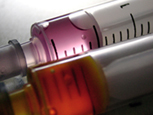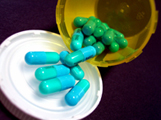



The Ethics of Using Animals in Research
Cristina Rodriguez
Biology Senior Seminar
BIO 410
Dr. Stan Grove
Fall, 2006.
Outline
I. Introduction
II. Animal Research Statistics Methods and Scenarios
III. Moral perspectives on the ethical dilemmas of balancing human benefits against animal harms in scientific research.
IV. Position of the scientific community on the use of animals in research.
V. Position of non scientific community
VI. Conclusion
I. Introduction
Animal research has been used as a method of study, when the study of humans is deemed impractical or unethical. In the last century major important medical advances have benefited directly or indirectly from animal research. However, serious ethical issues arise regarding the use of animals. Animals are subjected to painful procedures or toxic exposures that leave them injured, living impaired or even dead. In addition these techniques result in high levels of stress in animals and altered physiological functions often leading to inconclusive results. The replacement of animal methods as much as possible with non-animal techniques would yield both ethical and technical advantages. The exploration and implementation of non-animal methods should be a priority for investigators and research institutions, and should take advantage of a wide variety of viewpoints to ensure progress toward scientific, human health, and animal protection goals.
II. Animal Research Statistics Methods and Scenarios
According to the Nuffield Council on Bioethics (2004) and The British Union for the abolition of Vivisection (BUAV, 2005), it is estimated it that fifty to a hundred million animals worldwide are used annually and then killed afterwards in scientific procedures every year, 10–11 million of them in the European Union. In 2004 the U.S. Department of Agriculture (USDA) reported that 1.2 million mammals (not including rats and mice) were used in research, which included 64,932 dogs, 23,640 cats and 54,998 non-human primates (USDA, 2004). Accurate figures for animal testing are difficult to collect. Animal organizations estimate that 23-25 million animals are used in experiments each year solely in the US (LPAG, 2004). Is impossible to know exactly how many animals are being used in research because U.S. laws do not require scientists to report how many mice, rats, or birds they use. Rodents such as rats (15%), Mice (68%) and other rodents (1%) are used in the majority of the procedures. They constitute 85% of the total. Most of the remaining procedures use fish (8%), birds (4%), reptiles and amphibians (1%), and other mammals such as monkeys, dogs and cats (3%) (U.K. home office, 2005).
Experiments that use animals are conducted as a part of three overlapping goals or aims: the first one is basic research, in which experiments are conducted with no direct commercial application or other practical end in mind. The ultimate goal is to gain knowledge and many Scientifics argue that valuable findings have often risen from these experiments. This kind of research is most often performed in universities.
Another category is applied research, which is conducted to solve specific biological problems or to develop commercial products. It can be done for medical or non-medical use. Compared to basic research, which is more academically oriented, applied research experiments are more likely to be carried out in the pharmaceutical industry although some universities may conduct these experiments in commercial partnership (Wikipedia, 2006). Applied research has often been related to the treatment or cure of disease and disorder in humans and other animals. Animals are also used in toxicology in where commercial products are tested on subjects to measure potential adverse reactions to chemicals. The biological responses to these ingredients are also measured. This type of study focuses on the symptoms, mechanisms, treatment and detection of poisoning. The observed criteria used to measure the toxicity of chemicals are dose and the amount of exposure to the chemical. Toxicology tests include: drug testing, and cosmetic testing (Wikipedia, 2006). Due to the serious, adverse side effects that some drugs have presented in the past. Many countries passed new laws to ensure that all new pharmaceutical products have to go through rigorous animal testing before being licensed for human use. Cosmetics testing is probably the most controversial of the categories mentioned above. Individual or several ingredients are tested in animals as well as finished products such as lipstick and mascara. Cosmetic testing is banned in several countries in the European Union (EU) such as the Netherlands, Belgium, and the UK (Cook, 2006). In 2002 the European Parliament agreed with EU members to ban the use of animals for cosmetics testing starting in 2009 (Stephens, 2002). This agreement would also include a ban on the import and marketing of cosmetic products that have used animal’s experiments in their manufacture.
Because of the strong feelings that some of the public has against cosmetic animal testing, most cosmetic manufacturers would state in their labels that the products are not tested on animals (CCF,2006). However, they are still required by consumer protection laws to maintain rigorous standards so their products are not toxic and dangerous to public health, and make sure that the ingredients are not dangerous in large quantities. The United States and Japan require animal testing to meet legal requirements for which they are strongly criticized by groups that disagree with testing animals for cosmetics (Wikipedia, 2006). Although some companies have stopped animal testing as they state on their product label, some animal organizations suspect that several companies may falsely claim that they do not do perform tests in animals or not state it (CCF, 2006).
III. Moral perspectives on the ethical dilemmas of balancing human benefits against animal harms in scientific research.
Scientific animal testing has also been very controversial because of the use of animal models. Animal models are non-human animals with a disease that is similar to a human condition. These models allow researchers to observe and investigate diseases in ways that would be impossible in human beings because they would imply a high level of harm to a human patient that would not be considered ethical. Scientist use animal models to learn more about the evolution and progression of diseases as well as their diagnosis and treatment. Animal model diseases can be spontaneous or induced by physical, chemical or biological means. For instance, infecting animals with pathogens to reproduce human infectious diseases applying radiation to cause tumors and genetically selecting animals (such as diabetic mice). Drugs are also used to mimic a disease. Cardiazol is a commercial drug used as a circulatory and respiratory stimulant. Larger doses of this drug cause convulsions (Cordy,1978). This drug has been used in many investigations as an animal model of epilepsy. It has also been used to study the seizure phenomenon and to try to identify different pharmaceuticals that may control and reduce seizures.
In the last century, humans and animals have benefited directly or indirectly from animal research, from antibiotics and insulin to blood transfusions and treatments for cancer and HIV (Cook, 2006). Many of these medical achievements have earned the Nobel Prize (FBR, 2006). The scientific community argues that the acceptability of using animals in research rests on both expectations that the research findings will be meaningful and substantial and that the suffering of animals will be minimal (Royal Society, 2006). The view that human beings have the right to make this decision is based on various philosophical arguments.
IV. Position of the scientific community on the use of animals in research
The royal society is one of the oldest scientific academies in continuous existence. It has promoted excellence in science among it members. Some representative names that can be pulled out of this fellowship list are Isaac Newton, Charles Darwin, Albert Einstein, Dorothy and Stephen Hawking. This organization also funds many research projects worldwide and is an excellent representative of how the scientific community feels about animal research. This scientific entity supports animal research by stating that “modern biology with all its contributions to the well being of society is heavily dependant on research on animals” they also say that “the benefits provide the justification for the research that lead to them.” (Royal Society, 2006)
Other institutions that justify animal testing in a moral basis is the British House of Lords. In a report in 2002 they state that morality, society and law are founded “on the belief that human beings are unique amongst animals.” They say that “Humans are therefore morally entitled to use animals, whether in the laboratory, the farmyard or the house, for their own purposes." Also they say that human beings are unique amongst animals. This belief is goes along with a further belief that there is a moral obligation “to develop medical and veterinary science for the relief of suffering " and that is a moral duty to minimize animal suffering in these procedures as much as possible (House of Lords, 2002). Another justification is the belief that animals may suffer less during experiments than human beings would, because some people argue that although animals have similar pain receptors and central nervous system pathways, non-human mammals suffer less because they have a reduced capacity to remember and to anticipate pain (House of Lords, 2002).
Part of the ethical justification for the use of animals is that scientific procedures depend on it and also because there is a moral obligation to increase the knowledge in every way possible so that new therapies and drugs can be developed to ease the suffering caused by lines and other conditions (Royal Society, 2006). Many scientists and governments agree that if animals are to be used in experiments, procedures should be carried out so that the animal subjects experience minimal discomfort or distress, and that animals should be used only if there is no other method available to deliver consistent and substantial results. Three guiding principles are used in many countries to observe the use of animals. They are commonly called the Three R’s: Reduction, Replacement and Refinement (BBC, 2004). Reduction refers to methods that enable researchers to obtain comparable results from fewer animals, or to obtain more information from the same number of animals. Replacement refers to the preference for non-animal methods over animal methods whenever the results won’t be affected. And refinement refers to methods to alleviate or minimize potential pain suffering and distress that animals go through the procedures (Wikipedia, 2006).
Some organizations, part of the general public and scientists that advocate for animal testing also argue that it would be unethical to administrate substances and drugs that might have dangerous side effects to humans. In addition some experiments need to observe the variables for large periods of time; humans can not be confined in a laboratory for extended periods of time. One of the most popular claims of the pro- animal testing arguments is that living systems are necessary to study the interaction among cells, tissue and organs, along with it studies of infections by lethal pathogens such as Ebola and HIV would be impossible to be done in humans (NCABR, 2002).
Animals are used in experiments because they have a shorter reproductive span, and some animals are specially bred for experimentation purposes. Other pro-animal experimentation proponents contend that a large number of animals are used by humans for other purposes including agriculture, hunting, pest control, than are used in animal testing. 100 million animals are killed by hunting each year (HSUS, 2006) A census done in the United states in 2006 estimated that 150 million large mammals are used in agriculture each year (USDA, 2004). Hundreds of millions of rats are killed in pest control procedures. (APS, 2006). Millions dogs and cats are euthanized from animal shelters each year, and a million animals are killed each day by automobiles (USDA, 2004).
V. Position of non scientific community
Opponents of animal testing strongly contest these views and question the scientific community whether sacrificing millions of animals was necessary to achieve these results (PETA, 2006). They say that some experiments are conducted with no practical end in mind such as the procedure done is in order to write academic papers to acquire a Ph. D or and academic tenure, and not because the research is beneficial. They also say that the suffering of animals is excessive compared with the results obtained. In addition some groups say that Animal testing facilities are not properly regulated. They claim that several undercover investigations have led to evidence of animal cruelty and abuse in Universities and pharmaceutical companies (PETA 2006). Opponents say that there is no justification for animal torture and regard animal investigations as a bad science because some of the conditions are induced (animal models). They say that these conditions should not be compared with the same disease in humans. For instance Parkinson disease can not be simulated by causing brain damage to animal whether by administrating drugs or by other means (BUAV, 2005). Also several drugs have dangerous side affects that were not predicted by animal models. Many drugs had had to have been pulled off the market a good example is Vioxx and Thalidomide. The latter was sold as a prescription drug to stop nausea in pregnant woman during the 1960s. It was used in Europe and other parts of the world; the drug was never approved for sale in the United States. Unfortunately, scientists discovered that it caused birth defects (Cordy, 1978). PETA, one of the biggest animal organizations claims that this drug was indeed tested in animals however it did not predict the disastrous side effects (Carnell, 1995).
Some drugs also appear to have different effects on human and non-human animals a good example would be aspirin that acts as a teratogen (causing congenital malformations). Also, animal activists claim that the stressful laboratory conditions in which these experiments are conducted may affect the results (Wikipedia, 2006). Laboratory environment and the experiments affect every organ and biochemical functions in the body. Many animals are subjected to isolation, pain, physiological distress, hyper sexuality, early separation from the mother, surgery and anesthesia and overcrowding among other factors, these would decrease viral resistance and immune response in animals (BUAV, 2005).
Animal rights groups strongly believe that human beings have no moral right to use individual animals in ways that would not benefit those individuals. Today, there are two major accepted alternatives, Computer simulation and in vitro cell culture techniques. Many of these techniques are still under development and many of them would still need to use data from prior animal experiments or other animal derived animals’ cultures. However, these would significantly decrease the number of animals used in experiments. Examples of computer simulation models include diabetes asthma and drug absorption (MB labs, 2006). Cell culture has proven to be the most effective and it has been used for more than 30 years for cosmetic and other tests by some laboratories. Micro-dosing using voluntary human subjects is also becoming popular. In these assessments, the drugs that are administrated give doses below the doses that would produce a whole body effect. Some institutions that carry on alternatives to animal’s testing include: The John Hopkins Center for Alternatives to animal testing, The university of California Center for animal testing (Wikipedia, 2006).
Animal research is a very controversial topic. Personally I have mixed feelings regarding this issue. Although major medical advances that have benefited animal and human beings in the last century used animals in their experiments, some of the tests conducted indeed involve animal cruelty and they should be heavily regulated. The scientific community should take advantage of a wide variety of alternatives that are being developed, such as non-animal testing techniques. This will ensure progress toward science, human health, and animal protection goals.
Bibliography
APS (2006), What Do USDA "Animal Use" Numbers Mean? Retrieved October 16, 2006 from the American Physiological society website: http://www.the- aps.org/pa/resources/bionews/animalNumbers.htm
BBC (July 17, 2004), Hot topics, Animal Experiments, retrieved October 19, 2006 from the BBC website: http://www.bbc.co.uk/science/hottopics/animalexperiments/alternatives.shtml
BUAV (2005), British Union for the Abolition of Vivisection, Faqs Vivisection, Retrieved October 14, 2006 from The British Union for the Abolition of Vivisection (BUAV) website: http://www.buav.org/aboutus/index.html.
Carnell B. (1995), Thalidomide. Retrieved October 16, 2006 from Animal rights.net website: http://www.animalrights.net/archives/related_topics/topics/medical_research/thalidomide.html
CCF (2006)Choose Cruelty Free, Preferred product list, retrieved October 21, 2006 from the Choose Cruelty website: http://www.choosecrueltyfree.org.au/index.html
Cook, Kristina. (March, 2006) Facts about Animal Research, Retrieved October 19, 2006 from Pro-test website: http://pro-test.org.uk/2006/03/facts-about-animal-research.html
Cordy D. (1978) Aspirin in pregnancy: maternal and fetal effects, Retrieved October 20,2006. from PubMed website: http://www.ncbi.nlm.nih.gov/entrez/query.fcgi?cmd=Retrieve&db=pubmed&dopt=Abstr act&list_uids=364401&query_hl=31&itool=pubmed_docsum.
MB Research Laboratories (2006) Alternative and In Vitro Toxicology Test Method. Retrieved October 18, 2006 from MB research laboratories web site: http://www.mbresearch.com/
Nuffield Council on Bioethics (2005), The Ethics of Involving Animals in Research Report, Retrieved October 17, 2006 from the Nuffield Council on Bioethics website: http://www.nuffieldbioethics.org/fileLibrary/pdf/RIA_Report_FINAL-opt.pdf
LPAG (Laboratory primate advocacy group) (2004), Number of research animals . Retrieved October 16, 2006 from the LPAG website: http://www.lpag.org/layperson/layperson.html#number
NCABR., (2002) The Care of Use of Animals in Biomedical Research Retrieved October 16, 2006 from the North Carolina Association of Biomedical research website: http://www.ncabr.org/biomed/FAQ_animal/faq_animal_8.html
FBR (2006). Nobel PrizesThe Payoff from Animal Research. Retrieved October 16, 2006 from Foundation for Biochemical Research website: http://www.fbresearch.org/Education/nobels.htm
House of Lords (24 July 2002) Animals in Scientific Procedures Report, Retrieved October 16, 2006 from the United Kingdom Parliament webpage: http://www.publications.parliament.uk/pa/ld/ldanimal.htm
(HSUS) Wildlife Issues. Hunting (2006). Retrieved October 18, 2006 from The humane society of the United states webpage: http://www.hsus.org/wildlife/issues_facing_wildlife/hunting/
PETA (2006) Peta’s action center. Animal testing. Retrieved October 16, 2006 from People for the ethical treatment of animals web site: http://www.peta.org/actioncenter/testing.asp
Royal Society (2006).Animals in Research. Science Issues. Retrieved October 16, 2006 from Royal Society web site: http://www.royalsoc.ac.uk/landing.asp?id=1222
Stephens, A (2002). Animal rights slam EU testing ban. Retrieved October 19, 2006 from CNN/world website: http://edition.cnn.com/2002/WORLD/europe/11/07/eu.cosmetics/index.html
U.K. Home Office (2005). Statistics on Living AnimalsGrat Britain 2005 . Retrieved October 19, 2006 from the U.K. Home Officewebsite: http://www.homeoffice.gov.uk/rds/pdfs06/spanimals05.pdf
(USDA), United States Department of Agriculture (2004, fiscal year). Animals used in Research Report. Retrieved October 16, 2006 from the USDA webpage: http://www.aphis.usda.gov/ac/awreports/awreport2004.pdf
Wikipedia (2006), Research methods. Retrieved October 16, 2006 from Wikipedia the free encyclopedia webpage:http://en.wikipedia.org/wiki/Research#Basic_research.